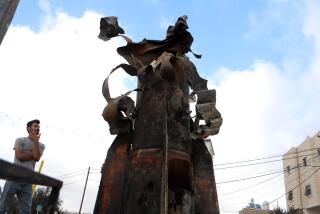Iran’s revolution isn’t going away
- Share via
NEVER UNDERESTIMATE a revolutionary regime. In particular, never underestimate the durability of the revolutionaries’ fervor to fight for their cause.
The French Revolution began in 1789, but it was only after two decades of war that the fight was finally knocked out of it. The Russian Revolution began in 1917, but the Soviet Union posed a mortal threat until the mid-1980s. As for the Communist Chinese revolution of 1949, it was only last month that the regime in Beijing was threatening to go nuclear over Taiwan.
People in the English-speaking world never give up hoping that the revolutionaries will suddenly see the advantages of peace, the rule of law and representative government. That may be because they think their own revolutions -- the English Revolution of the 1640s and the American Revolution of the 1770s -- followed that pattern. Yet there was no more bellicose British government than Cromwell’s. And the United States was scarcely a peaceful power as it expanded from sea to shining sea in the century after independence.
So it was pure fantasy to imagine that the Islamic Republic of Iran, founded in revolutionary year 1979, was just about to mutate into a friendly democracy. Yet people did. “In Iran,” President Bush declared in a speech in November 2003, “the demand for democracy is strong and broad.” Dream on. Far from being on the brink of democracy, Iran is now on the brink of becoming the single biggest threat to democracy in the world.
Last Monday, the Iranian government flatly rejected a European package of political and economic incentives to halt its covert nuclear weapons program. With a defiant flourish, the Iranians reopened their uranium-conversion plant at Isfahan. The Iranians say their aim is merely to become a “nuclear fuel producer and supplier within a decade.” Given that they are among the biggest oil producers in the world, this rush toward nuclear power is a mite suspicious. It’s certainly not motivated by a desire to combat global warming.
The reality is that an Iranian nuke could be a reality within a decade, if not sooner. All the Iranians need is time -- and this we seem to be giving them.
The problem is that, once again, the West is divided and the international community stalemated. Britain, France and Germany have long favored diplomatic carrots. The U.S. might once have preferred a military stick, but is now too tied up in neighboring Iraq to relish the prospect even of air strikes.
Now it seems likely that Washington’s Plan B will be adopted -- to go to the U.N. Security Council. But don’t get too excited. First, the American aim is simply to threaten economic sanctions. With oil at $66 a barrel, the Iranians are unlikely to be intimidated. Second, any U.N. resolution needs to be requested by the 35 nations represented in the International Atomic Energy Agency and approved by all five permanent members of the Security Council.
The irony is that the resumption of the Iranian nuclear program comes just weeks after presidential elections that were interpreted in the West as a victory for populism. Indeed, the reopening of the Isfahan plant has been practically the first act of the new president, Mahmoud Ahmadinejad.
To be sure, Ahmadinejad’s victory was not achieved without irregularities. On the other hand, it’s hard to pretend that his victory over the favorite, Hashemi Rafsanjani, was wholly rigged. Rafsanjani was the candidate backed by all the grand ayatollahs of the holy city of Qom as well as the Society of Combatant Clergy. Yet Ahmadinejad routed him by 17 million votes to 10 million.
BUT WASN’T democracy supposed to be what the neocons wanted in Iran? Unfortunately, they forgot that the passage of time does not necessarily favor moderates in a revolutionary regime. Ahmadinejad’s hostility to “the corrupt Western way of life” could scarcely be more explicit. As one of his supporters told the Washington Times: “I picked Ahmadinejad to slap America in the face.”
Obviously, Ahmadinejad’s victory is proof that democracy in the Middle East does not necessarily translate into victories for Western liberalism. On the contrary, it may reveal the popularity of fundamentalism and nationalism among the impoverished Muslim masses. But it also suggests that Americans and Europeans are misreading the trajectory of the Iranian revolution.
What we are witnessing is the old revolutionary story: The generation forged by revolutionary war turns out to be more belligerent than the generation that led the revolution itself. Significantly, Ahmadinejad’s main election backers were the Islamic Revolutionary Guard Corps and the Basiji, the paramilitary popular militias formed during the Iran-Iraq war. Ahmadinejad is himself a war veteran, one of hundreds of thousands of Iranians who came of age under fire.
SO WHERE do we go from here? Plan A -- the European carrot -- has failed. Plan B -- the flaccid U.N. stick -- will also fail. Is there then a Plan C -- American (or Israeli) air strikes?
The answer is yes, but it is a plan fraught with peril.
According to Michael J. Mazarr of the U.S. National War College, Iran could retaliate with “an elaborate, ferocious, global provocation designed to draw the United States into a protracted conflict.” That translates into more terrorism in our cities and an escalation of the war in Iraq.
Now, ask yourself, what would be the likely effect of such a confrontation on Iranian politics?
To repeat: The Iranian revolution is still at an early stage. It has not yet produced its Bonaparte, its Stalin, its Mao. Or has it? A full-scale war with the “Great Satan” may be all Ahmadinejad needs to don that bloody mantle.
More to Read
Sign up for Essential California
The most important California stories and recommendations in your inbox every morning.
You may occasionally receive promotional content from the Los Angeles Times.










